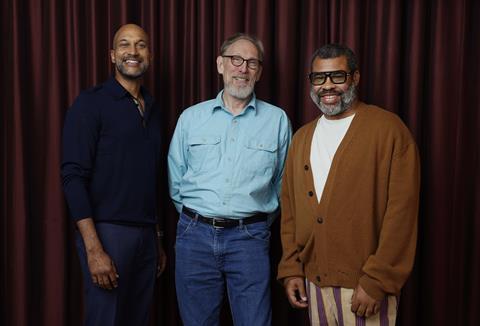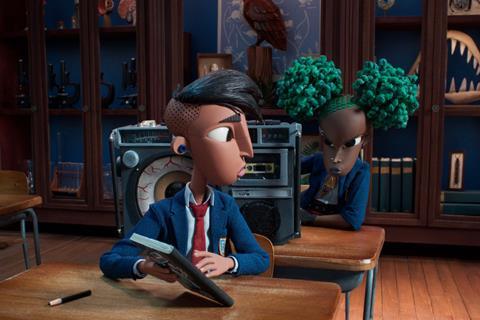Henry Selick made his name with animations exploring the dark and macabre — but has kept a low profile since Coraline. Returning with demonic tale Wendell & Wild, the filmmaker tells Dan Jolin about a rich collaboration

It is hard to imagine Henry Selick doing anything other than stop-motion. “As a kid, it was the type of animation that affected me most strongly,” the 70-year-old director says. “Primarily Ray Harryhausen’s work. I love the methodology, and the final results are still the most magical for me. It’s still a miracle that someone can breathe life into a figure.”
Selick first made his mark with delightfully macabre The Nightmare Before Christmas in 1993 — “though I didn’t get much credit for it, as it was called Tim Burton’s film”, he drily notes. (Burton, who Selick met while working at Walt Disney Studios in the late 1970s, conceived and produced the film.) Then, following further success with Roald Dahl adaptation James And The Giant Peach in 1996 and suffering a flop with 2001’s Monkeybone (starring a live-action Brendan Fraser), Selick triumphed once more in 2009 with the exquisitely disturbing Coraline, based on the beloved children’s novella by Neil Gaiman.
“I’m very, very proud of Coraline,” Selick says. “The most gratifying thing is there’s a lot of cosplay and a lot of tattoos. I’ve seen Jack Skellington [from The Nightmare Before Christmas], Snow White and Coraline all together on one person’s back!”
It remains to be seen whether or not characters from Selick’s new film Wendell & Wild will appear inked on people’s skin, but the Netflix-backed feature — which landed on the streamer in October following a Toronto International Film Festival launch — is certainly close to his previous work in its morbid tendencies. It stars Keegan-Michael Key and Jordan Peele — in striking caricature-puppet form — as a pair of low-achieving demon brothers who draw a young, tearaway orphan girl into their hellish shenanigans with a promise to bring her parents back from the dead.
But it’s taken a long time to arrive — 13 years after Coraline, in fact. Even in the slow-moving world of stop-motion that is a long time — especially when you’re following an Oscar-nominated hit. It appeared that Selick’s career had become more stop, less motion.
“After I did Coraline, I made this deal to work with Disney and Pixar,” explains the filmmaker. “I have a history with them, and I knew John Lasseter [then CCO of both companies] — I went to school with him. I was doing an original movie there called The Shadow King, with a budget that was a lot lower than the big Pixar films, and the deal was they would leave me alone. But they couldn’t leave me alone. It was John’s nature to rework things to death. That’s the Pixar method — they try every permutation. We had a big creative clash, and the budget just crept up and up to the point where they shut it down.” Selick was crushed. “After two years, we only had five minutes of finished footage,” he says. “I was so discouraged after that about doing another stop-motion film. It took a while to get back on my feet.”
Inspiration finally returned in 2012, courtesy of TV sketch comedy series Key & Peele, which hugely impressed Selick. So he reached out to Peele. “Wendell & Wild was something I’d actually written years before, as a seven-page story inspired by my two sons when they were little demons,” he says. “I never did anything with it, but seeing Key & Peele I felt, ‘Wow. They could play the two demons! This could be a movie!’”
Peele, it transpired, was a fan of Selick’s, and of stop-motion in general; he majored in puppetry at Sarah Lawrence College. So not only was he willing to act in the film (bringing Key with him), he also took it on at his nascent company Monkeypaw Productions and proposed he co-write with Selick, investing it with his own sensibility and cultural touchstones. This proved particularly fortunate when the time came to pitch the project, as by then Peele had made his feature-film debut with the hugely successful thriller Get Out.
“At that point, I was just holding onto Jordan’s coattails because everyone wanted to be in the Jordan business,” laughs Selick. “But we didn’t go to any of the traditional animation studios, because we knew Wendell & Wild was kind of a crazy story. We just went to a few places, and Netflix was the one place that really liked the story.”
Choppy seas

Once they were set up at Netflix, it wasn’t entirely smooth sailing, however. “There were a lot of battles,” Selick says. Fortunately, Peele “was brilliant at the politics of dealing with the studio. Where I’m quicker to lose my temper, he’s very even-keeled.”
Aside from creative tensions, the Portland, Oregon-based production was also beset by plague (shutting down with Covid), fire (“we had [wild]fires get so close to the studio we had to evacuate the puppets”), and a whole litany of setbacks: “There was a lot of civil unrest in Portland. There were some surprising late-in-the-season ice storms, power outages… It felt like the Old Testament story of Job. But we were indomitable. It brought everyone together, this sense that we’re going to get it done no matter what was thrown our way.”
Aside from the joy of reuniting Key and Peele in his recording booth (“The outtakes could make for a Grammy-winning comedy album”), Selick is feeling good about how his little demons have turned out. “It’s the first time I’ve made something intended to be streamed, and the best thing about it is your movie is there, it stays there, and people have a good while to find it,” he says.
Things might also be looking up for his aborted The Shadow King project. “I got the rights back to my original story,” he confirms. “So that might be revisited.” But at the moment, the front-runner in his plans is a return to the material of Neil Gaiman.
“It’s not The Graveyard Book,” Selick advises, referring to Gaiman’s 2008 young adult novel, which was previously mooted as a follow-up to The Shadow King. “It’s his best book,” Selick teases — although he won’t reveal the name of it. “I would love to work with Neil again. Depending on which side of the bed he wakes up on, I may or may not be in business with him again.”
And that business will have to be stop-motion. “I don’t want to do it as a CG film — and people have offered that,” he insists. “I like mechanical stuff. I like analogue stuff — even though we use a lot of modern digital tools to help us. I am attracted to old stuff — old ideas and doing them well.”
























No comments yet